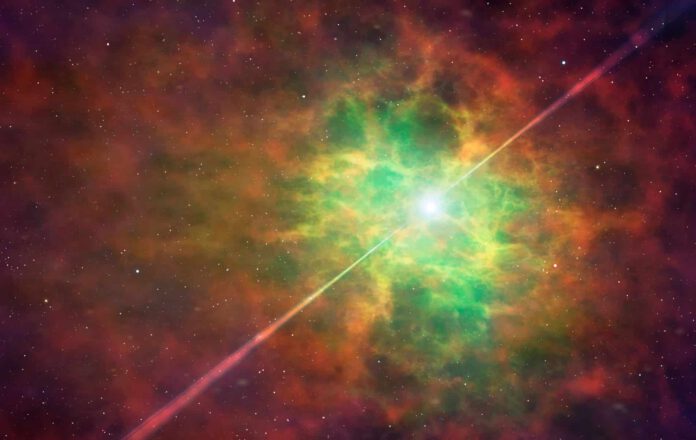
Scientists have finally identified the mysterious aftermath of Supernova 1987A. The star that exploded in 1987 has been confirmed to have evolved into a neutron star.
The uncertainty regarding the identity of Supernova 1987A lingered for quite some time. Would it reveal itself as a black hole or a neutron star? Thanks to observations of ionized argon and sulphur atoms using the James Webb Space Telescope (JWST), astronomers now believe it has taken on the form of a neutron star. Among the researchers was scientist Mike Barlow. He notes: “For the research, we used the MIRI and NIRSpec spectrometers to determine the strong presence of ionized argon and sulphur. These measurements came from the direct center of the dust cloud hiding the neutron star, providing direct evidence of a central ionizing radiation source. According to our data, we can confidently assert that this must be a neutron star.” The findings have been published in the journal Science.
The James Webb Space Telescope
The researchers relied heavily on the JWST for their investigations. The telescope’s onboard instruments are adept at capturing infrared light, which is crucial for such studies. The large dust cloud currently concealing Supernova 1987A has made it difficult for scientists to discern what remains of the exploded star. A few years ago, researchers thought they spotted a neutron star but were unable to state this assertion with total certainty. Now, there is hard evidence supporting the claim beyond doubt. Colleague scientist Claes Fransson shares, “Thanks to the sharp resolution of the JWST, we were able to look right into the center of the dust cloud for the first time. We now know for certain there is a compact source of ionizing radiation. It is by using the JWST that we were able to confirm our predictions for the first time.”
Understanding Supernovae
The importance of these discoveries should not be underestimated. However, to truly comprehend why they are so essential, one must return to a time before the supernova event took place. Not all stars are identical. Some, like our Sun, gradually expand towards the end of their life cycle. In contrast, others, significantly larger and heavier stars like Supernova 1987A, play out another narrative. The gravitational forces at play within such stars prevent them from expanding towards the end of their lives. Instead, the massive weight causes these stars to collapse inward, resulting in colossal explosions referred to as ‘Type II supernovae’.
These supernovae are both fascinating and fundamentally crucial to the universe. During the explosion, the star’s building blocks are violently shaken and merged, creating entirely new (often heavier) elements. These new elements then spread throughout the universe. What remains after a supernova can vary. It might leave behind a neutron star, or continuing implosion can lead to a black hole forming. Barlow explains, “Supernovae are the primary sources of the chemical elements that make up life. Therefore, it is all the more important that our models regarding supernovae are made clear and to work properly. There are no other objects like the neutron star in Supernova 1987A, a neutron star so close and recently formed. The dust cloud has been expanding for a while now, which means we will likely see more of the neutron star.”
The Next Piece of the Puzzle
However, there is a missing piece to this cosmic puzzle: the exact origin of the ionizing radiation remains unknown. Barlow concludes: “There are two potential sources for the ionizing radiation. In the first instance, the ionizing radiation might emanate from the hot surface of the neutron star, which is currently hotter than a million degrees Celsius. Alternatively, the high-speed rotation of the neutron star might have transformed it into a pulsar, thereby generating an ionizing wind in the surrounding material by hurling charged particles.”
There is a lot more to be said about Supernova 1987A. For instance, a few months ago, the JWST discovered two strange ‘half-moons’ in the dust cloud. If you’re interested in learning more about this topic, you might want to look into this.











